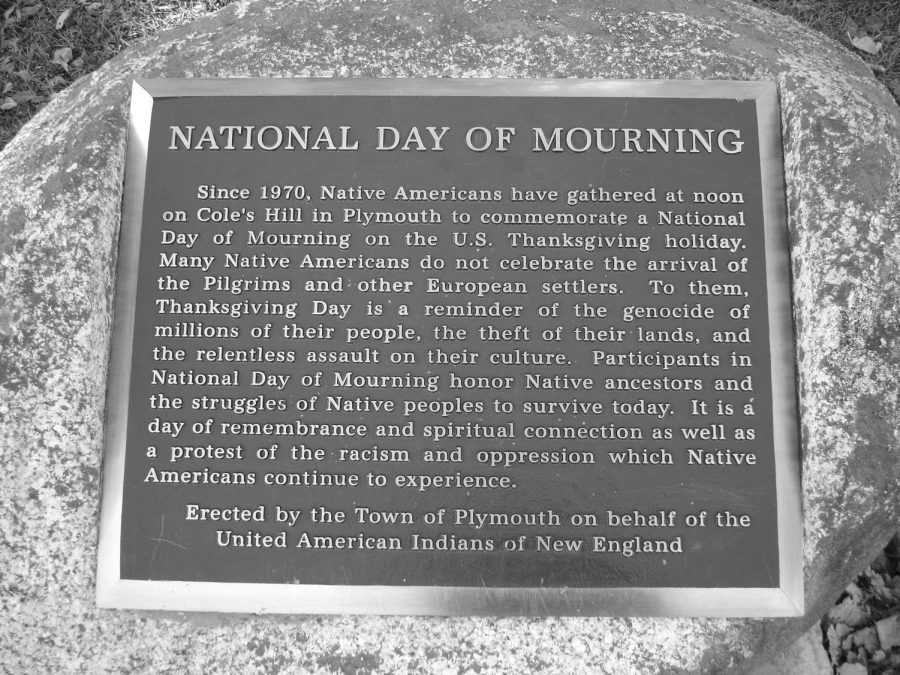A Different Perspective On Thanksgiving
Every November, when millions of American families muster around their dining room tables to feast on turkey, mashed potatoes, and enough pumpkin pie to make you nauseous, a faction of Native descendants, particularly of the Wampanoag and other northeastern tribes, congregate in Plymouth center to hold their National Day Of Mourning. They employ this occasion to ventilate the unremitting struggles of Native Americans and pay homage to their deceased ancestors, because, for many, Thanksgiving does not represent generosity and giving – it represents thievery and taking.
The tale of the Pilgrims and Native Americans’ convoluted relationship is often a theme in elementary Social Studies classes because it is chronicled as a lighthearted story of congeniality between two very disparate groups of people. By way of whitewashing and hefty censorship, America has managed to force-feed its most impressionable citizens a fiction – one that describes the Pilgrims as an amiable clan scouring for religious freedom and the Native Americans as magnanimous folks who simply allowed the Europeans to annex their homeland. According to the myth, they shared a bountiful harvest at the end of 1621. Unfortunately, this jubilant story of friendship and sharing-is-caring has been fabricated, but, because it is instilled in our minds as fact-based, many people have grown up with ample misconceptions about Thanksgiving and the holiday’s background.
The fact of the matter is, the European Colonists and Indigenous People had a tumultuous relationship that cannot be summed up within one serendipitous feast. The foundation of their affinity is stolen land – when the Europeans first docked in Massachusetts, they believed that they merely had the right to overtake other peoples’ homes, and did not refrain from utilizing atrocious warfare to acquire said land. The colonists dehumanized the Native people, referring to them as “savages” and “uncivilized,” and attempted to recondition their “bizarre practices” when they were just culturally incompatible. And, shockingly, some do not even cite the 1621 harvest as the “first Thanksgiving” – many historians have determined that the first Thanksgiving commenced in 1637, after the notorious Pequot Massacre, a slaughter of the Native Americans of Mystic, Connecticut at the hands of Massachusetts colonizers, after which the Massachusetts governor, John Winthrop, entailed festivities to celebrate the conquest.
The fallacies and illusions that pervade Thanksgiving’s history are cut-and-dry examples of the winners writing history. Because those winners were wallowing in the unblemished pool of American gallantry and perfectionism, we’re still perpetuating a story that indoctrinates children to have the same vainglorious mindset. Obviously, the abominations committed by the colonizers are not the fault of anyone alive today. But, it is our fault if we continue to neglect these very real anecdotes that have caustically imprinted the lives of so many. The goal of extrapolating this hard-to-swallow truth is not to torpedo your perspective of Thanksgiving or devastate the bliss inspired by these traditions. It’s simply a wake-up call that, like other idealized American customs, the true history is much bleaker than the glamorized version. So, this Thanksgiving, when you’re parked at your dining room table with a turkey, potatoes, and cranberry sauce heaped on your dish, don’t memorialize the Pilgrims – memorialize the Native Americans who have been so cruelly mistreated; there’s no rectifying this tragedy, there’s only acknowledging it, but acknowledgment is the first step towards compassion and improvement.










